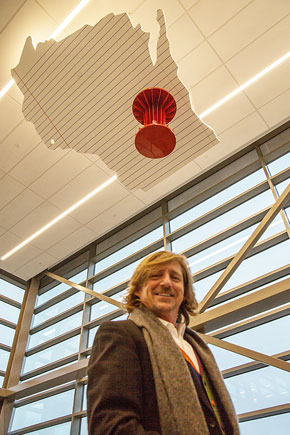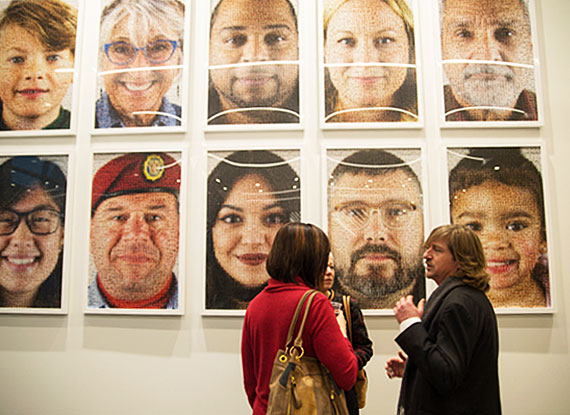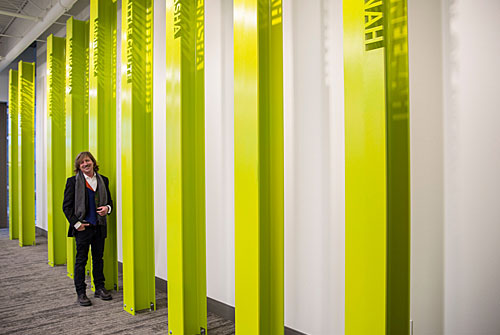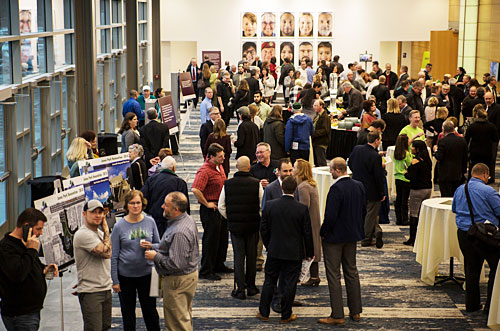When the city of Appleton threw a grand-opening party Jan. 11 for its new $31.9 million downtown exhibition center, Lawrence University art professor Rob Neilson’s talents were one of the building’s star attractions.

Three projects of Neilson’s — “You Are Here,” “We Are Here” and “Community Caryatids,” a series of 10 I-beams representing each of the local municipalities contributing financially to the center — provide an artistic connection between the 30,000-square-foot facility, the people and communities who built it and the visitors it will serve.
Neilson proved he’s not only highly creative, he also can work fast. From the time he was first selected for the art commission from among three finalists to the completion of all three projects: 10 months.
“I’ve done projects that are three, four years, but this was very quick and a lot of work,” said Neilson, the Frederick R. Layton Professor of Art at Lawrence. “I was teaching at the same time.”
Two of the projects are designed to complement each other. “You Are Here” is a 12-foot–by-13-foot sculpture project suspended from the ceiling of the ground-level floor. It features a cutout of the state of Wisconsin with a giant red pushpin inserted where the Fox Cities would be on the map. “We Are Here” is a series of 10 oversized portraits each comprised of 1,000 individual headshots shot last summer and fall of citizens from throughout the Fox Cities.
“The sculpture project was where I started. I was thinking about what is this exhibition center, what is our community trying to do?,” Neilson explained. “They’re trying to get people to the Fox Cities, get people to come and stay. It’s about travel, destination, the history of this place and how geography and landscape has shaped this community.
“So, I was really thinking about how to do a three-dimensional representation of all those ideas; the river, history, paper, travel, destination. That all just came together in a way that I’m used to working, thinking, developing ideas.”

Neilson was presented with a second opportunity to propose something for a space on the lower level and the photography portrait piece “was a natural.”
“Of course, if you’re doing ‘You Are Here,’ you have to do ‘We Are Here,’” said Neilson. “I had done the sculpture about the history, the paper industry, the river, travel and destination. The other thing that the Fox Cities does so well is community. It was natural going to one project from the other.”
As a sculptor, the portrait project was a giant step outside of Neilson’s experience with a rather steep learning curve.
“My photography skills up until this point were limited to what I needed to know to take a photo of the sculptures I make,” said Neilson with a laugh. “I had to figure out how I wanted to do this, the lighting, what was the right aperture. I needed these all to be consistent so it could become one big piece.”
“The project really was me in the community, talking with people, meeting with people, people collaborating with us, telling us how happy they were. That was meaningful in a way I wasn’t prepared for and it was a great surprise.
— Rob Neilson
Despite his self-admitted photographic limitations, the bigger challenge, he discovered, was a game plan for actually taking 10,000 individual head shots in a very compressed time frame.
“How do I get images, how do I get people engaged, the logistics of it all was the thing that was keeping me up nights,” said Neilson, who found himself taking pictures seven days a week, including many days that stretched to 12-plus hours.
Saturday morning downtown Appleton farmer’s market crowds provided Neilson with plenty of potential, if not sometimes leery, subjects.
“The first time we went out on Oct. 21, people didn’t quite understand what we were doing. Given the setting, people assumed we were there to sell something. I can’t tell you how many times we had to say, before they even got to ask, ‘100% free!’ That was the line.
“Once we started rolling, once people understood what we were doing, we didn’t have to sell the idea every single time. It bloomed rapidly,” added Neilson, who said every person who had their picture taken wound up in one of the final portraits.
While he doesn’t like to name favorites among his many public art works, Neilson said the photography project is one that will stay with him forever.

“The project really was me in the community, talking with people, meeting with people, people collaborating with us, telling us how happy they were,” he said. “That was meaningful in a way I wasn’t prepared for and it was a great surprise.
“It’s profound when it’s something in the place I’ve been living for 15 years. It’s the only home my kids know. This is our hometown. This is where we live. I go through those photos and I know these are my neighbors, my friends, people I work with, people I’ve met, people I interacted with. I don’t know how many opportunities we get to experience that kind of thing in our lives. But I’m fortunate to have had that opportunity and I will never forget that.”
The center’s third project was the result of a bit of happenstance. While attending a meeting about ways Miron Construction, the building’s general contractor, could recognize the communities involved with its construction, Neilson was asked if he had any ideas.
“I just stood up and said what it was on top of my head. You need columns, you need pillars, something that is holding this place up, figuratively and literally.”

The finished product is a series of 10, 10-foot tall I-beams, each with the name of one of the communities cut into the flange of the I-beam,
“It’s supposed to be figuratively holding this place up, the 10 communities,” Neilson explained. “This sounds ridiculous, but they look exactly like I designed them.”
Appleton is home to several other public art projects by Neilson, including engraved manhole covers depicting some aspect of compassion. He also has done projects in Los Angeles, Charlotte., N.C., and for the Long Beach Transit Authority. The Expo Center projects were capstone of very happily busy year for Neilson.
“It was a big year for me. I had more shows last year than I’d ever had. More exhibitions than I’d ever had in a single year my whole professional life. I did more talks on public art, had been in more newspapers, magazines and on television than I’d ever been by far in a single year. It was some of the hardest work I’ve done and it was great.”
About Lawrence University
Founded in 1847, Lawrence University uniquely integrates a college of liberal arts and sciences with a nationally recognized conservatory of music, both devoted exclusively to undergraduate education. It was selected for inclusion in the book “Colleges That Change Lives: 40 Schools That Will Change the Way You Think About College.” Engaged learning, the development of multiple interests and community outreach are central to the Lawrence experience. Lawrence draws its 1,500 students from nearly every state and more than 50 countries.